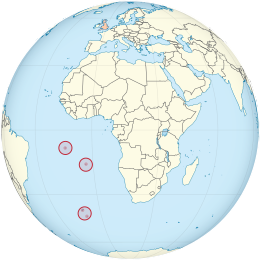Commons:Urheberrechtsregeln nach Gebiet/St. Helena, Ascension und Tristan da Cunha
|
Urheberrechtsregeln: St. Helena, Ascension und Tristan da Cunha Kürzel: COM:ST. HELENA, ASCENSION UND TRISTAN DA CUNHA | |
 | |
 | |
| Schutzfrist | |
|---|---|
| Standard | 50 Jahre p. m. a. |
| Fotografie | Veröffentlichung + 50 Jahre |
| Anonym | Veröffentlichung + 50 Jahre |
| Posthum | Veröffentlichung + 50 Jahre |
| Andere | |
| Frist geht bis zum Jahresende | Ja |
| Gemeinsame Lizenzvorlagen | {{PD-old-auto}} |
| Abkommen | |
| Berner Übereinkunft | 5. Dezember 1887 |
| Welturheberrechtsabkommen | 27. September 1957 |
| Welthandelsorganisation-Mitglied | 1. Januar 1995 |
| URAA-Wiederherstellungsdatum* | 1. Januar 1996 |
| WIPO-Urheberrechtsvertrag | 14. März 2010 |
| *Ein Werk ist in der Regel in den USA geschützt, wenn es sich um eine Art von Werk handelt, das in den USA urheberrechtsfähig ist, nach 31 December 1928 veröffentlicht wurde und im Ursprungsland am URAA-Datum geschützt ist. | |
Diese Seite bietet einen Überblick über die Urheberrechtsregeln von St. Helena, Ascension und Tristan da Cunha, die für das Hochladen von Werken in Wikimedia Commons relevant sind. Beachte, dass jedes Werk, das aus St. Helena, Ascension und Tristan da Cunha stammt, sowohl auf St. Helena als auch in den Vereinigten Staaten gemeinfrei oder unter einer freien Lizenz verfügbar sein muss, bevor es auf Wikimedia Commons hochgeladen werden kann. Bei Zweifeln über den urheberrechtlichen Status eines Werks aus St. Helena solltest du die entsprechenden Gesetze zur Klärung heranziehen.
Hintergrund
Saint Helena, Ascension and Tristan da Cunha is a British Overseas Territory in the South Atlantic. It consists of Saint Helena, Ascension Island and the archipelago of Tristan da Cunha. Saint Helena has a Governor and a Legislative Council, whilst Tristan da Cunha and Ascension each have an Administrator and an Island Council.
The United Kingdom Copyright Act 1956 applied to overseas territories, including Saint Helena, except for ss. 32, 34, 35, 42 & 44 and Schedules 4 & 5, as defined by the Copyright (St Helena) Order 1963 (SI 1963/1038). The United Kingdom's Copyright (Computer Software) Amendment Act 1985 except ss. 4(3), & 5 did not apply to St Helena.[1] The World Intellectual Property Organization (WIPO), an agency of the United Nations, holds the text of the Copyright Act 1956 in their WIPO Lex database.[2]
Allgemeine Regeln
Under the Copyright Act 1956,
- Copyright subsisting in a work ... shall continue to subsist until the end of the period of 50 years from the end of the calendar year in which the author died, and shall then expire.[1956 Sec.2(3), 3(4)]
- If the work had not been made public before the death of the author, copyright shall continue to subsist until the end of the period of 50 years from the end of the calendar year which it was made public.[1956 Sec.2(3), 3(4)]
- Where the first publication of a literary, dramatic, or musical work. or of an artistic work other than a photograph, is anonymous or pseudonymous, any copyright subsisting in the work ... shall continue to subsist until the end of the period of 50 years from the end of the calendar year in which the work was first published, and shall then expire.[1956 2nd Sched. Sec.2]
- The copyright in a photograph shall continue to subsist until the end of the period of 50 years from the end of the calendar year in which the photograph is first published, and shall then expire.[1956 Sec.3(4b)]
Freedom of panorama
![]() OK for works of architecture, sculptures, and artistic craftsmanship. Freedom of panorama is provided by Sections 9(3) and 9(4) of the Copyright Act 1956. For other types of works (like street art),
OK for works of architecture, sculptures, and artistic craftsmanship. Freedom of panorama is provided by Sections 9(3) and 9(4) of the Copyright Act 1956. For other types of works (like street art), ![]() Nicht OK. Per Section 9(5), unspecified artistic works can only be included in broadcasts or films in an incidental manner, or at background (de minimis valid for audio-visual media only).
Nicht OK. Per Section 9(5), unspecified artistic works can only be included in broadcasts or films in an incidental manner, or at background (de minimis valid for audio-visual media only).
The FoP legal rights are identical to British overseas territories still using the 1956 copyright law (like the British Virgin Islands and the Falkland Islands), all are modelled upon the British version, see also Commons:Copyright rules by territory/United Kingdom#Freedom of panorama.
Siehe auch
- Saint Helena, Ascension and Tristan da Cunha
- Commons:Urheberrechtsregeln nach Gebiet/Britische Überseegebiete
- Commons:Urheberrechtsregeln nach Gebiet/Vereinigtes Königreich
Zitate
- ↑ List of UK laws applied to St Helena, Ascension and Tristan da Cunha: Revised Edition 2017. Saint Helena Government. Retrieved on 2019-03-11.
- ↑ Copyright Act, 1956 4 & 5 ELIZ. 2 CH. 74. United Kingdom.